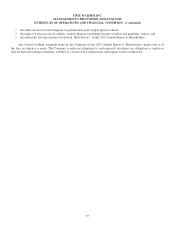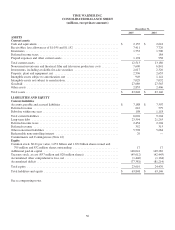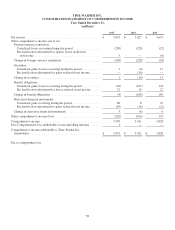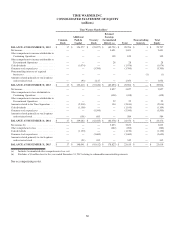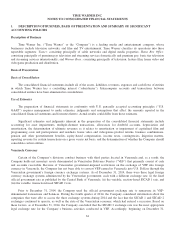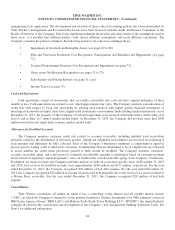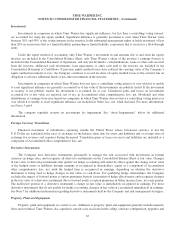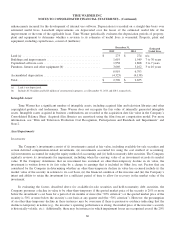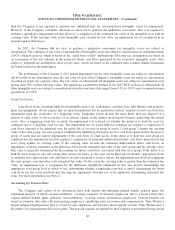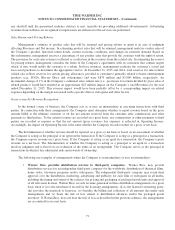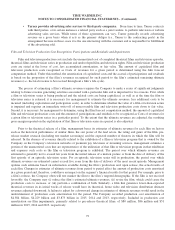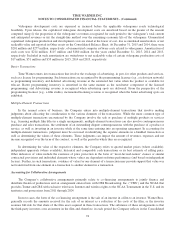Time Magazine 2015 Annual Report Download - page 79
Download and view the complete annual report
Please find page 79 of the 2015 Time Magazine annual report below. You can navigate through the pages in the report by either clicking on the pages listed below, or by using the keyword search tool below to find specific information within the annual report.TIME WARNER INC.
NOTES TO CONSOLIDATED FINANCIAL STATEMENTS - (Continued)
Investments
Investments in companies in which Time Warner has significant influence, but less than a controlling voting interest,
are accounted for using the equity method. Significant influence is generally presumed to exist when Time Warner owns
between 20% and 50% of the voting interests in the investee, holds substantial management rights or holds an interest of less
than 20% in an investee that is a limited liability partnership or limited liability corporation that is treated as a flow-through
entity.
Under the equity method of accounting, only Time Warner’s investment in and amounts due to and from the equity
investee are included in the Consolidated Balance Sheet; only Time Warner’s share of the investee’s earnings (losses) is
included in the Consolidated Statement of Operations; and only the dividends, cash distributions, loans or other cash received
from the investee, additional cash investments, loan repayments or other cash paid to the investee are included in the
Consolidated Statement of Cash Flows. If previous equity method losses have reduced the carrying value of the Company’s
equity method investment to zero, the Company continues to record its share of equity method losses to the extent it has an
obligation to advance additional funds or has other investments in the investee.
Investments in companies in which Time Warner does not have a controlling voting interest or over which it is unable
to exert significant influence are generally accounted for at fair value if the investments are publicly traded. If the investment
or security is not publicly traded, the investment is accounted for at cost. Unrealized gains and losses on investments
accounted for at fair value are reported, net of tax, in Accumulated other comprehensive loss, net. Dividends and other
distributions of earnings from investments in companies in which Time Warner does not have a controlling voting interest or
over which it is unable to exert significant influence are included in Other loss, net, when declared. For more information,
see Notes 3 and 4.
The company regularly reviews its investments for impairment. See “Asset Impairments” below for additional
information.
Foreign Currency Translation
Financial statements of subsidiaries operating outside the United States whose functional currency is not the
U.S. Dollar are translated at the rates of exchange on the balance sheet date for assets and liabilities and at average rates of
exchange for revenues and expenses during the period. Translation gains or losses on assets and liabilities are included as a
component of Accumulated other comprehensive loss, net.
Derivative Instruments
The Company uses derivative instruments principally to manage the risk associated with movements in foreign
currency exchange rates, and recognizes all derivative instruments on the Consolidated Balance Sheet at fair value. Changes
in fair value of derivative instruments that qualify for hedge accounting will either be offset against the change in fair value
of the hedged assets or liabilities through earnings or recognized in shareholders’ equity as a component of Accumulated
other comprehensive loss, net, until the hedged item is recognized in earnings, depending on whether the derivative
instrument is being used to hedge changes in fair value or cash flows. For qualifying hedge relationships, the Company
excludes the impact of forward points or option premiums from its assessment of hedge effectiveness and recognizes changes
in the fair value of a derivative instrument due to forward points or option premiums in Other income (loss), net each quarter.
The ineffective portion of a derivative instrument’s change in fair value is immediately recognized in earnings. For those
derivative instruments that do not qualify for hedge accounting, changes in fair value are recognized immediately in earnings.
See Note 7 for additional information regarding derivative instruments held by the Company and risk management strategies.
Property, Plant and Equipment
Property, plant and equipment are stated at cost. Additions to property, plant and equipment generally include material,
labor and overhead. Time Warner also capitalizes certain costs associated with coding, software configuration, upgrades and
65


